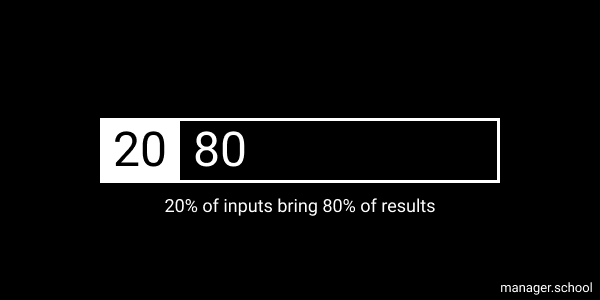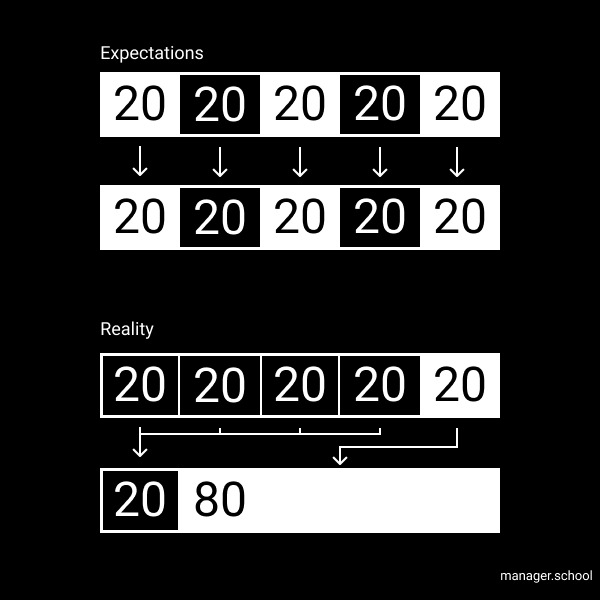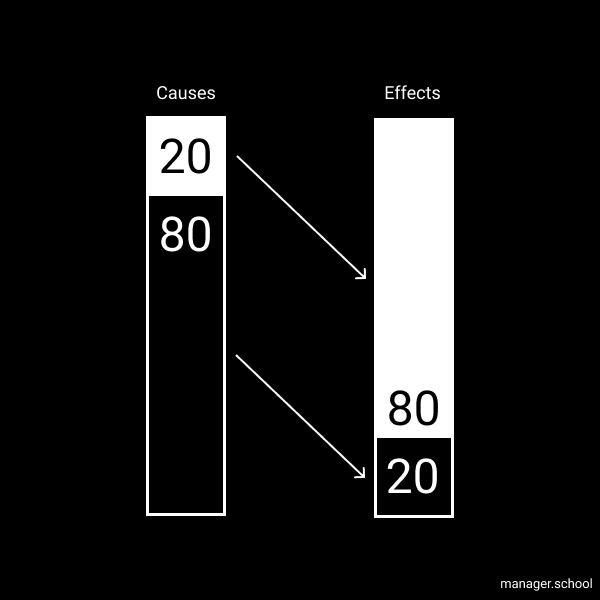Ruthless prioritization is something we all know we should do more often, but it’s tricky to actually accomplish.
Product is a lot like golf — you’re rewarded for doing fewer things more accurately. In my work coaching teams, one of the biggest pitfalls I see teams commit regularly is to equate activity to progress. This is especially toxic for product teams.
Just because you’re doing something doesn’t mean you’re doing the best thing.
The 80/20 rule is a critical mental model to understand for product managers. It not only describes why your team can struggle to make progress, but it helps you execute an effective product strategy.
What is the 80/20 rule?

In 1896 Vilfredo Pareto, an Italian economist, made a unique observation while harvesting peas. He found that 80% of his peas came from 20% of the pods.
Pareto observed this same pattern in wealth distribution. 80% of the land in Italy was held by 20% of the population.
Now known as the 80/20 rule, the Pareto principle teaches that the majority of results come from a minority of the inputs.
This applies across multiple domains:
-
- 80% of crime is committed by 20% of criminals
- 80% of sales come from 20% of customers
- 80% of donations come from 20% of donors
- 80% of revenue come from 20% of products
- 80% of complaints come from 20% of clients
And beyond business results and societal trends, it can apply to the way your team works:
-
- 80% of results come from 20% of your team
- 80% of productivity comes from 20% of the tasks on your todo list
- 80% of issues are caused by 20% of bugs
- 80% of stress comes from 20% of issues
Note: Don’t get caught up on the exact number (it’s possible in some places that you have a 30/70 or 10/90 split). But the concept that inputs and outputs have an unequal relationship can help you make decisions about where to focus.
Take it further with the fractal nature of 80/20

The juiciest insight about the 80/20 principle that most people aren’t familiar with is the fact that the principle is fractal.
This means that not only do 80% of results come from the 20% of effort but using 80/20 on those top results we see that 64% of results come from 4% of efforts. And one level further 51% of results come from less than 1% of efforts!
We see this all the time in product work. Small changes lead to major results.
- Google’s home page is BY FAR the most visited website on the internet
- Airbnb found that taking professional pictures made a HUGE difference in booking levels
- LinkedIn got to a million followers first by leveraging email invites for massive growth
- In my work, I saw engagement double in one app I managed from a single executive endorsement
What does this mean? Well, finding the 1% of changes that will bring 51% of your results is key. This is why agile is such an important concept. Ideas like iteration and fast-paced learning increase the likelihood that you’ll find the 1% activities.
If your team is only testing one idea per release, you are going to fall behind someone else testing dozens a week. This is one reason startups can run circles around most established companies—they test more, faster.
4 ways you can use 80/20 to improve your product

1. Identify the 20%
You’re more likely to find the 20% when you consider problems to solve than solutions to build. Almost every team spends too little time defining, redefining, and communicating the problem to solve.
A key question to ask yourself is “How much time do I spend identifying the 20%?” For a product team, that means dedicating time to discovery (user conversations, competitive analysis) and experimentation (prototyping, releasing MVPs, and watching the impact on metrics).
2. Stop the 80%.
Regularly ask yourself “What 80% could I stop, delegate, or defer?”
The reality is that most teams spend far too much time on features that won’t deliver business value. This is why I advocate product teams spend at least 50% of their time in the acquisition and activation parts of AARRR. It can be tempting to spend time deep in your funnel, but your impact is limited if you have leaks in the early parts of your experience.
3. Say no more often
By saying “No” to just a few things or people, you can free up time and attention. You have to practice not only identifying when you should say no, but also how to tell someone “No”.
To tell someone no you actually use a lot of words that aren’t “No”. Explaining why. Walk them through the tradeoffs. Or get them to do the work required for a “yes”. These are all ways to help influence when you don’t have authority.
4. Take more time to identify value.
Don’t spend more time planning and thinking. Take sufficient time for reflection. Don’t skip user research conversations, planning meetings, or retros.
How you can use 80/20 to improve your team

As a product manager, your biggest impact can be through enabling your team to focus on the right work. One way to describe the job of a product manager is that you make sure the right decisions get made and the right people are involved in those decisions. This is a clear path to deliver the best possible results.
As an added benefit, using this principle to improve your team not only impacts your results but makes work more fun. Everyone likes contributing to meaningful work.
Here are some questions you should ask in order to improve your team:
-
- How can we direct more of my time towards more valuable activities?
- Are we spending 80% of our time on the most important 20% of tasks?
- How might we find time to do this with tasks we choose, the employees I focus on, the customers we pay attention to?
Once your team becomes aware of 80/20 rule and starts spending more time improving the way work happens, you’ll find it easier to keep that improvement up.
Retrospectives are a great routine to ensure your team has identified and focused on their 20%.
How to get started using 80/20 today
So, where do you start?
First, if you don’t know how you create value, you need to spend time figuring that out. This is true for the value your product creates and for the value you create in your work.
Take 5 minutes to start listing out answers for these questions (with either your product or your work):
-
- What outcomes do you want?
- What activities do you do?
- Which outcomes are most important?
- Which activities best contribute to those important outcomes?
- How might you spend more time on the activities that contribute to the outcomes you actually want?
Once you go through this process of capturing, organizing, and deciding, you have a list to help you center the work you actually do.
Tip: If something is hard to bucket, then break the activity down. For instance, if I write “Sales” that’s a 20% activity … but then I can break that down into “Follow-up with active leads” and that’s a more important task than “Reach out to new people”. It doesn’t matter how many people I get into my sales pipeline if I’m not taking care of those who have already shown interest. Taking time to regularly think about and revisit this activity can help you say no to more activities and yes to the best ones.
Takeaways
- 80/20 is a simple rule that explains why certain activities bring outsized results. Applied to your product and your work, this is a sure way to find more success.
- The fractal nature of 80/20 means that not only does 20% of activity lead to 80% of results, but 4% of activity leads to 64% of results and 1% of activity leads to 51% of results.
- 80/20 applies not only to your product but also to your team.
- You should be spending ample time identifying, refining, and communicating what your 20% is.
The most important thing is to figure out the most important thing. Don’t just identify activities, but focus on which problems are most important to solve.

